Jan. 18 show
Indiana's most mysterious county?
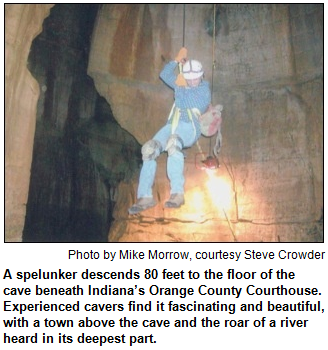 With a limestone cave beneath the county seat of Paoli, a village underwater, colorful folklore involving the famous French Lick and West Baden Springs Hotels, a "lost" river and some Confederate sympathizers during the Civil War, Orange County in far-southwestern Indiana may be our most mysterious.
With a limestone cave beneath the county seat of Paoli, a village underwater, colorful folklore involving the famous French Lick and West Baden Springs Hotels, a "lost" river and some Confederate sympathizers during the Civil War, Orange County in far-southwestern Indiana may be our most mysterious.
We will explore the limestone cave beneath the historic Orange County Courthouse, where one of Nelson's guests has been a court reporter for more than 40 years. She is Orange County native Diane Dillard, a historic preservationist.
Her late husband, Arthur Dillard, a former prosecuting attorney, completed the manuscript for a book about Orange County's colorful heritage, Casinos, Copperheads, Pioneers and Politicians (Hawthorne Publishing, 2012), before his death.
In addition to Diane, Nelson's guests will be two historians/authors with their own links to Orange County's heritage.
 They will include Jim Fadely, who is considered the top expert on Thomas Taggart (1856-1929), the Irish immigrant-turned-Indianapolis mayor-turned French Lick hotel owner who brought international attention to the resort and its mineral springs and spas.
They will include Jim Fadely, who is considered the top expert on Thomas Taggart (1856-1929), the Irish immigrant-turned-Indianapolis mayor-turned French Lick hotel owner who brought international attention to the resort and its mineral springs and spas.
Jim, an administrator at University High School, is heading up a campaign to restore the long-neglected Taggart Memorial at Riverside Park in Indianapolis; Indiana Landmarks had placed the limestone monument on its 10 Most Endangered list for a couple of years.
Nelson's guests also will include author Nancy Niblack Baxter of Hawthorne Publishing, who edited Casinos, Copperheads, Pioneers and Politicians. 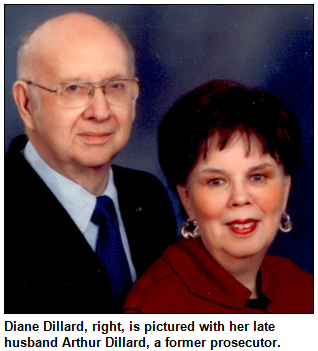 The casinos in the title refer to gambling that, although illegal in the early 1900s, openly flourished during the first heyday of the French Lick hotel and its arch-rival in West Baden.
The casinos in the title refer to gambling that, although illegal in the early 1900s, openly flourished during the first heyday of the French Lick hotel and its arch-rival in West Baden.
Owners of the West Baden hotel, built in 1902, included a flamboyant entrepreneur, Ed Ballard, who, like Taggart, rose from humble beginnings to become a millionaire. Our guest Jim Fadely will share insights about Ballard, who was shot to death in Hot Springs, Ark., in 1936.
The West Baden hotel, called the "Eighth Wonder of the World" upon its opening in 1902 because of its spectacular atrium and other features, closed as a hotel in the 1930s. After a lavish restoration spearheaded by the late philanthropist Bill Cook and his wife, Gayle, the West Baden Springs Hotel reopened in 2007. The Cooks also oversaw the restoration of the French Lick Springs Hotel.
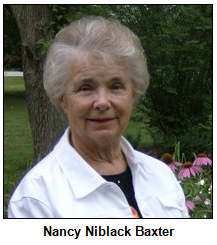 Earlier hotels on the French Lick site - including one that may have been a "hotbed of Copperhead activity" - are described in Casinos, Copperheads, Pioneers and Politicians. ("Copperhead" was a term for Southern sympathizers during the Civil War; it derives from copper buttons some wore.)
Earlier hotels on the French Lick site - including one that may have been a "hotbed of Copperhead activity" - are described in Casinos, Copperheads, Pioneers and Politicians. ("Copperhead" was a term for Southern sympathizers during the Civil War; it derives from copper buttons some wore.)
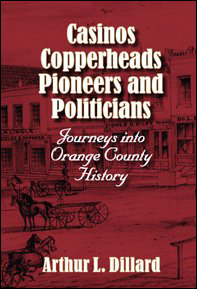 The Copperhead presence is analyzed by Arthur Dillard, a former president of the Orange County Historical Society, who spent years researching folklore about the county.
The Copperhead presence is analyzed by Arthur Dillard, a former president of the Orange County Historical Society, who spent years researching folklore about the county.
The mysterious cave underneath a vast section of Paoli, including the impressive courthouse, exists in part because, as his book puts it, "Ice Age glaciers did not touch this region."
In fact, the cave includes a cavern bigger than the courthouse, according to the book.
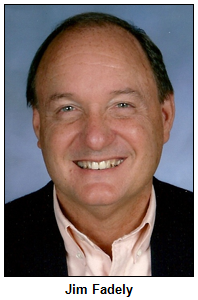 Diane and Nancy will share insights about that, as well as about Newton Stewart, an Orange County village that thrived during the late 1800s but had been abandoned by the early 1970s. Subsequently, the village was flooded as part of the creation of Patoka Lake.
Diane and Nancy will share insights about that, as well as about Newton Stewart, an Orange County village that thrived during the late 1800s but had been abandoned by the early 1970s. Subsequently, the village was flooded as part of the creation of Patoka Lake.
They also will discuss bygone dry goods and general stores that once thrived in Orange County, as well as such mysterious street and place names as Moonshine Hollow, Grease County Road, Tater Road and Hog's Defeat Creek. The area's mineral springs appealed to Native Americans decades before white settlers arrived. 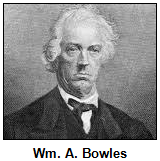 French Lick's distinctive name derives from the fact that French explorers had obtained salt from the springs.
French Lick's distinctive name derives from the fact that French explorers had obtained salt from the springs.
According to Casinos, Copperheads, Pioneers and Politicians, the valley's first hotel, which was known as the French Lick House, opened in 1845. Its owner was William A. Bowles, a Confederate sympathizer, physician and civic leader.
His hotel was a predecessor of the spectacular French Lick Springs Hotel that Taggart, a nationally powerful Democrat, marketed in the early 1900s to guests, including the Rockefellers, Roosevelts, Vanderbilts and Studebakers. (The memorial to Taggart was built in Riverside Park because, as Indy's mayor and a passionate advocate of parks, Taggart pushed for the city's purchase of the parkland despite critics who denounced it as a flood-prone "folly.")
 Our guest Jim Fadely, the chairman of the Taggart Memorial Task Force that is crusading to restore the memorial, is the author of Thomas Taggart: Public Servant, Political Boss (Indiana Historical Society Press).
Our guest Jim Fadely, the chairman of the Taggart Memorial Task Force that is crusading to restore the memorial, is the author of Thomas Taggart: Public Servant, Political Boss (Indiana Historical Society Press).
Just as Taggart was a Democratic power broker, various owners at the rival West Baden hotel were well-connected Republicans. As a result, when gambling linked to both hotels flourished during the early 1900s, local public officials often ignored the goings-on because leaders of both political parties were involved.
The atrium at the West Baden Springs Hotel was the world's largest free-span dome until the Astrodome in Houston opened in the 1960s.
West Baden had closed as a hotel during the Great Depression; then it was owned by Jesuit priests and, later, the Northwood Institute, which offered culinary, automotive and other training.
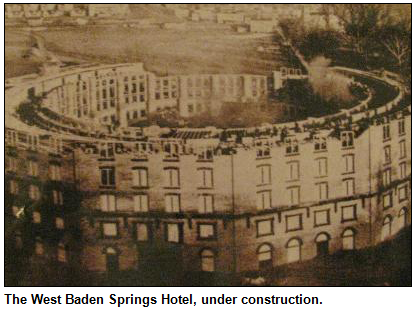 Ever since the lavish restoration, West Baden has again been a luxury hotel; it's a National Historic Landmark.
Ever since the lavish restoration, West Baden has again been a luxury hotel; it's a National Historic Landmark.
Other facts about the county with so many twists, turns and mysterious or historic features:
- The Orange County Courthouse, built in the Greek Revival style in 1850, is the state's second-oldest county courthouse in continual use. (The oldest is the Ohio County Courthouse.) Indy-based architect Jim Kienle shared insights during a Hoosier History Live! show in June 2010 following his restoration of the courthouse.
- According to Arthur Dillard's book, Moonshine Hollow is a name given by French Lick residents to a gulch on the south end of town because "illegally distilled whiskey was allegedly bartered or sold there."
- Arthur Dillard's grandfather was a blacksmith in Newton Stewart, the "town underwater."
Roadtrip: Kurt Vonnegut's Who am I this Time?
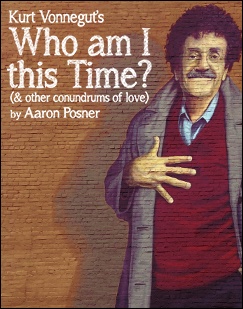 Guest Roadtripper Kelly Young of Baise Communications tells us about Kurt Vonnegut's Who am I this Time? - which opens at the Indiana Repertory Theatre on Jan. 28 and is directed by IRT artistic director Janet Allen.
Guest Roadtripper Kelly Young of Baise Communications tells us about Kurt Vonnegut's Who am I this Time? - which opens at the Indiana Repertory Theatre on Jan. 28 and is directed by IRT artistic director Janet Allen.
The show is a quirky collection of some of Vonnegut's most endearing characters who are searching for love and identity. The material is taken from the Indy hometown author's first short story collection, Welcome to the Monkey House.
Also at the IRT, And Then They Came for Me: Remembering the World of Anne Frank, opening Jan. 17. IRT Playwright in Residence James Still's most-produced play combines video and live performance, combining videotaped interviews with Holocaust survivors Ed Silverberg and Eva Schloss with live actors recreating scenes from their lives during World War II. James Still also been a guest on Hoosier History Live!
History Mystery
More than 100 years ago, the French Lick Springs Hotel became famous for selling Pluto water, the mineral water that was promoted as a curative for a range of ailments. Pluto water was marketed for many decades with an image of a red, devil-like figure who symbolized Pluto, ruler of the underworld.
 At the arch-rival West Baden Springs Hotel, "curative" mineral water was bottled and sold as well for many years in the early 1900s. Rather than call their product Pluto water, West Baden owners sold and marketed their mineral water under a different name.
At the arch-rival West Baden Springs Hotel, "curative" mineral water was bottled and sold as well for many years in the early 1900s. Rather than call their product Pluto water, West Baden owners sold and marketed their mineral water under a different name.
Question: What was the name of the mineral water sold at the West Baden Hotel?
Hint: The character who symbolized the water was an elf or gnome-like figure.
The call-in number is (317) 788-3314. Please do not call into the show until you hear Nelson pose the question on the air, and please do not try to win the prize if you have won any other prize on WICR during the last two months.
The prize is a gift certificate to the Winner's Circle Pub and Grille in downtown Indianapolis, and two tickets to the James Whitcomb Riley Museum Home, courtesy of Visit Indy.
By request, we are publishing the answer to the live History Mystery, in case you didn't catch it on the air. The Jan. 11 History Mystery question: Indiana native Ernie Pyle was the World War II journalist most admired by the American public and was killed during the war. In what state was he buried?
Answer: HAWAII.
Ernie Pyle's burial site is at the National Memorial Cemetery of the Pacific in Honolulu. Informally known as Punchbowl Cemetery, the national cemetery serves as a memorial to honor men and women who served in the U.S. armed forces and lost their lives doing so.
Ernie Pyle is one of the few American civilians killed during World War II to be awarded the Purple Heart. That distinction is noted on his gravestone at the memorial cemetery in Hawaii, which is visited by millions of tourists annually.
Pyle's parents had been sharecroppers in Dana, where his restored boyhood home is located.
Your Hoosier History Live! team,
Nelson Price, host and creative director
Molly Head, producer, (317) 927-9101
Richard Sullivan, webmaster and tech director
Pam Fraizer, graphic designer
Garry Chilluffo, creative consultant
Michele Goodrich, Jed Duvall, grant consultants
Joan Hostetler, photo historian
Dana Waddell, volunteer-at-large
www.hoosierhistorylive.org




Please tell our sponsors that you appreciate their support: Indiana Historical Society | Lucas Oil | Story Inn | The Fountain Square Theatre Building

 Acknowledgments to Monomedia, Visit Indy, WICR-FM, Fraizer Designs, Heritage Photo & Research Services, Derrick Lowhorn and many other individuals and organizations. We are an independently produced program and are self-supporting through organizational sponsorships and individual contributions. We do not receive any government funding. Visit our website to learn how you can support us financially. Also, see our Twitter feed and our Facebook page for regular updates.
Acknowledgments to Monomedia, Visit Indy, WICR-FM, Fraizer Designs, Heritage Photo & Research Services, Derrick Lowhorn and many other individuals and organizations. We are an independently produced program and are self-supporting through organizational sponsorships and individual contributions. We do not receive any government funding. Visit our website to learn how you can support us financially. Also, see our Twitter feed and our Facebook page for regular updates.
Save the date!
Anniversary soiree on Thursday, Feb. 27 - Be there!
Hoosier History Live! celebrates six years on the air with our annual birthday bash, hosted by our friends at Indiana Landmarks. Mark your calendar for Thursday, Feb. 27, 5 to 7:30 p.m. The event will be at Indiana Landmarks Center at 1201 Central Ave. in downtown Indianapolis. Watch our website for details!
Jan. 25 show
Crown Hill Cemetery history
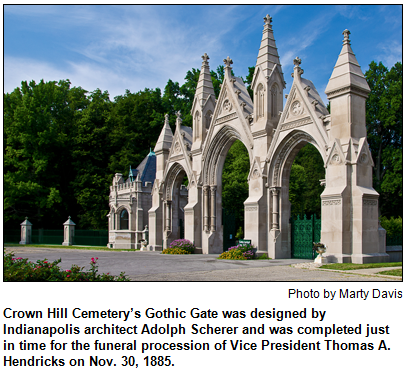 It's the third largest private cemetery in the country, with a history that has been intertwined with Indianapolis since the 1860s. Crown Hill Cemetery also is the burial site of more American vice presidents than any other cemetery, as well as the gravesite of notables ranging from bank robber John Dillinger to poet James Whitcomb Riley and former Indianapolis Colts owner Robert Irsay.
It's the third largest private cemetery in the country, with a history that has been intertwined with Indianapolis since the 1860s. Crown Hill Cemetery also is the burial site of more American vice presidents than any other cemetery, as well as the gravesite of notables ranging from bank robber John Dillinger to poet James Whitcomb Riley and former Indianapolis Colts owner Robert Irsay.
As the landmark cemetery (which has had more than 200,000 burials since it was dedicated in 1864) turns 150 years old, Nelson will explore its rich history, which also is being showcased in a lavish new book, Crown Hill: History, Spirit, Sanctuary (Indiana Historical Society Press).
He will be joined in studio by three guests, including Keith Norwalk, president of Crown Hill Cemetery, and Douglas Wissing, an award-winning, Bloomington-based journalist and author who wrote much of the text for the book. 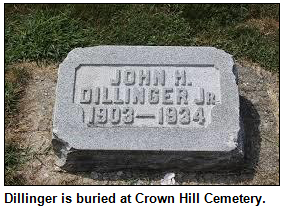 They also will be joined by Marty Davis of the Crown Hill Heritage Foundation, who took many of the book's photos.
They also will be joined by Marty Davis of the Crown Hill Heritage Foundation, who took many of the book's photos.
Crown Hill's creation resulted in some ways from problems and limitations involving the Hoosier capital's first major cemetery, a pioneer graveyard known as Greenlawn Cemetery.
Located near the White River, Greenlawn was prone to flooding - and it also, as Doug notes in the book, was overwhelmed by deaths during the Civil War. Civic leaders decided a spacious new cemetery was needed in a "park-like" setting on high ground. (As a tribute to James Whitcomb Riley, who died in 1916, the memorial monument for the "Hoosier poet" eventually was erected on the "crown" - or summit - of the cemetery. Riley had once written a poem titled At Crown Hill.)
A Pioneer Cemetery at Crown Hill has become the re-burial site of early Hoosier settlers. That's because their original graveyards have become "lost" (or closed, often for redevelopment), a topic that was the focus of a Hoosier History Live! show last June. 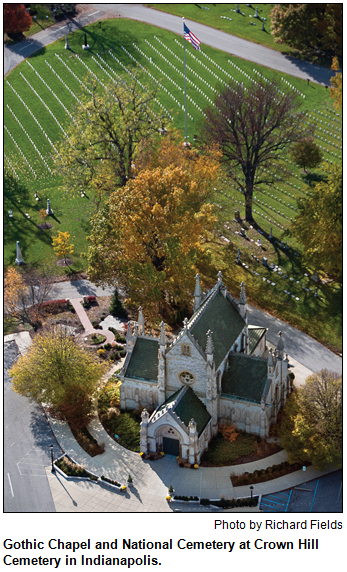 Many Hoosiers buried at Greenlawn were reburied in the Pioneer Cemetery.
Many Hoosiers buried at Greenlawn were reburied in the Pioneer Cemetery.
With its towering Gothic Gate built in 1885 at the eastern entryway off of West 34th Street, Crown Hill has scores of distinctive monuments, mausoleums and other gravesites. According to various reports, the most visited is the grave marker for Dillinger (1903-1934), who was known as Public Enemy No. 1. Some visitors even leave coins on his grave marker; the coins are donated to the Riley Children's Foundation.
Speaking of criminals: Vandalism of cemetery art sometimes has had a fortunate resolution. Our guest Keith Norwalk will share details about the 1995 theft - and recovery - of an 800-pound sculpture of a stone hunting dog that had rested next to the gravesite of his "master" since the 1880s. The stone dog was discovered across the country thanks to a sharp-eyed Crown Hill docent.
Some other history facts:
- First Lady Caroline Scott Harrison, who died of tuberculosis in the White House in 1892, is buried at Crown Hill. So is her husband, Benjamin Harrison, the only president elected from Indiana.
- The gravestone of Irsay, who died in 1997, has a giant horseshoe (symbolizing the Colts, of course) emblazoned on it.
- According to Crown Hill: History, Spirit, Sanctuary, one of the biggest funeral crowds in Crown Hill's history was for a potholder salesman. Our guest Doug Wissing will explain why the service in 1971 for the humble salesman, Herbert Wirth, drew a huge crowd of diverse mourners.
© 2014 Hoosier History Live! All rights reserved.